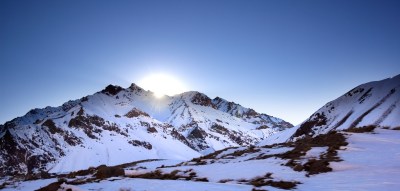EXPLORE: What Happens at Plate Boundaries?
| Site: | Mountain Heights Academy OER |
| Course: | Earth Science Q2 |
| Book: | EXPLORE: What Happens at Plate Boundaries? |
| Printed by: | Guest user |
| Date: | Thursday, 24 July 2025, 9:06 PM |
Description
.
1. REVIEW: Types of Plate Boundaries

CC BY.
There are three kinds of plate boundaries: convergent, divergent, and transform. Volcanoes and earthquakes can happen at each type of plate boundary. This week of the course will focus on volcanoes and mountains that result from the interactions between plates and how they, in turn, affect the other spheres of Earth. The following is a brief explanation of each type of plate boundary:
Convergent
There are several kinds of convergent plate boundaries.
1. Oceanic-Continental ConvergenceIn an oceanic - continental boundary the oceanic plate moves under the continental plate, forming volcanic mountain chains. For example: the Nazca Plate being subducted beneath the South American Plate to form the Andes Mountains. The Cascade Mountain range in the northwestern United States was also formed in this way, by subduction of an oceanic plate beneath a continental plate.
2. Oceanic-Oceanic ConvergenceAt an oceanic-oceanic convergent plate boundary, one oceanic plate is subducted beneath another oceanic plate. Deep ocean trenches are associated with this type of convergent plate boundary. For example: the Mariana Plate being subducted beneath the Pacific Plate, forming the Mariana Trench in the Pacific ocean. Volcanic islands can also be result of oceanic-oceanic boundaries. An example of this is the Aleutian Islands in the northern Pacific Ocean, off the coast of Alaska.
3. Continental-Continental ConvergenceA continental-continental convergent plate boundary is created when two continental plates collide. Continental-continental boundaries cause mountains to form. For example: the Indian Plate colliding with the Eurasian Plate, forming the Himalayan Mountains.
Divergent
Divergent boundaries are areas in which plates are moving away from each other. For example, divergent boundaries can be found in the mid-Atlantic ocean ridge, where magma pushes the plates apart to form new ocean crust.
Transform
Transform boundaries are areas in which two plates slide past each other; neither plate moves over or under the other. The San Andreas fault is an example of a transform boundary.
Source
http://pubs.usgs.gov/gip/dynamic/understanding.html (public domain)
2. VIEW: Volcanoes & Plate Movement
This screencast explores the different types of volcanoes and which types of plate boundaries they occur at and why.3. VIEW: Movement along Convergent Boundaries
Volcanoes are most often found along the boundaries where tectonic plates meet. Volcanoes are especially prevalent at convergent plate boundaries. One such zone, which encircles the Pacific Basin, is known as the Pacific Ring of Fire. Alaska, which is located at the boundary of the Pacific and North American plates, is home to more than 50 active volcanoes. Scientists study and vigilantly monitor Alaska's volcanoes because there are serious volcanic hazards that place both people and property at risk.
Alaska Volcano Observatory (AVO), uses a variety of tools—including seismometers (instruments that measure motions of the ground) and satellite images—to gather data about volcanoes. Months or weeks before an eruption, a volcano can show signs of unrest. For example, the movement of magma within a volcano can generate earthquakes and cause the surface to swell. Data gathered by satellites provides further information. For example, synthetic aperture radar (SAR) satellites can show changes in the shape of a volcano, thermal infrared (TIR) images display temperature differences, and color composite images provide information about surface materials. AVO analyzes satellite data twice daily for thermal anomalies (areas of higher temperature than normal) and ash plumes. Other instruments and techniques, such as global positioning systems, are also used to monitor changes in the surfaces of volcanoes (such as swelling and deformation). Volcanoes outside the seismic network are monitored by satellite imagery; observations of airplane pilots may prompt investigations as well.
Source: "Explore Alaska's Volcanoes." Teachers' Domain. 29 Jun. 2009. Web. 25 Jun. 2011.<http://www.teachersdomain.org/resource/ean08.sci.ess.earthsys.akvolcano/>.
4. VIEW: Hot Spots
Hot Spots
Another type of plate movement can also create volcanoes. Hot spots are areas where magma pushes up to the surface. As tectonic plates move over the hot spot, volcanic island chains are formed, such as the Hawaiian Islands. Volcanoes form when magma from beneath the Earth's crust breaks through the surface and erupts. As the lava cools, new islands are created. Every several thousand years a new island emerges from the sea.
"How to Build an Island from Scratch." Teachers' Domain. 18 Nov. 2008. Web. 26 Jun. 2011. <http://www.teachersdomain.org/resource/nat08.earth.geol.tec.build/>.
After you have completed this part of the lesson, you can check the associated box on the main course page to mark it as complete